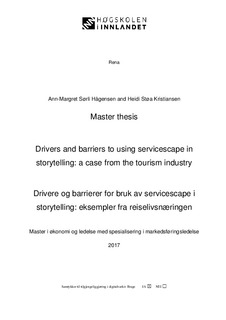| dc.description.abstract | Abstract (engelsk sammendrag)
There is a growing interest in creating positive experiences for consumers, especially in the tourism industry. Our context is farm tourism. One way to enhance the customer experience is by telling good stories (Mossberg, 2008). By linking the story to the servicescape, the stories will be even more effective at creating extraordinary experiences (Mossberg, 2008). Limited research has been conducted on the use of servicescape, and as far as we know, no study has yet investigated drivers and barriers to using servicescape in storytelling. However, these barriers and drivers might have an influence on the tourism provider’s use of the servicescape in storytelling. The research method chosen in this thesis was an explorative study with the use of in-depth interviews. Our interview guide was semi-structured. We found that there were several drivers and barrier to using the servicescape in storytelling. These were connected to authenticity, interest, knowledge, and resources. Authenticity was found to be important for the tourism provider, which is in line with research regarding this same topic from the perspective of tourists (Mossberg & Johansen, 2008). However, even though tourists demand only stories that can be perceived as authentic, it was not possible for the tourism provider to present stories connected to the servicescape that were not true. On the other hand, economy is a barrier for utilising and developing the servicescape, and will influence the way in which it can be used in storytelling. Furthermore, by using resources to develop the servicescape, economy will act as a driver for linking the latter to the stories. A link between the storytelling and the servicescape will influence the customer in a one-time purchase in a better way (Gilliam & Zablah, 2013). Furthermore, we found that knowledge is also a driver and a barrier for using the servicescape in storytelling. As a driver, knowledge about the history of the farm makes it easier for the tourism provider to make use of the servicescape. Lack of knowledge, on the other hand, will be a barrier to integrating the servicescape in storytelling. The tourism provider’s interest in the story is a driver for using the servicescape in storytelling. Knowledge and interest are important to tell a story in an effective way. The results of our research can help tourism providers to identify which of the drivers and barriers affect their use of the servicescape in storytelling. These providers can then seek to overcome the barriers and utilise the drivers, and in the end, tell better stories using the servicescape. Our study contributes new knowledge and a framework with findings about which drivers and barriers can influence the use of servicescape in storytelling. We suggest that our findings should be tested in future studies. | nb_NO |
